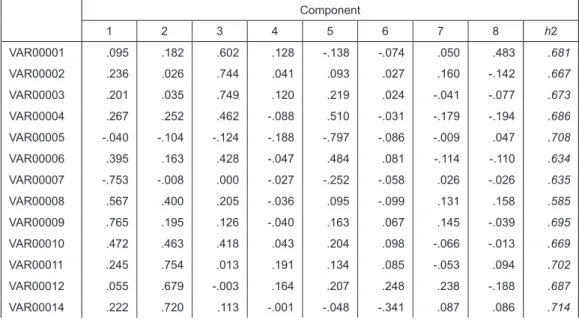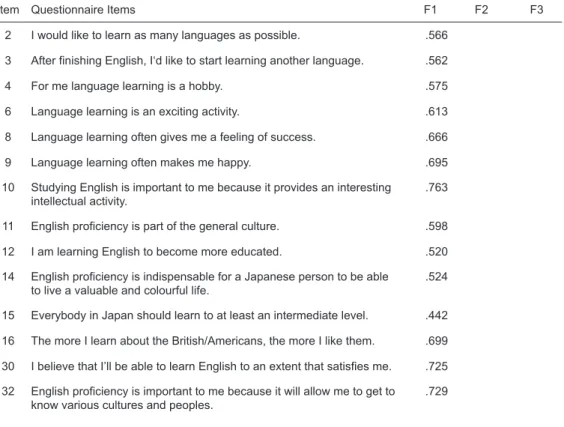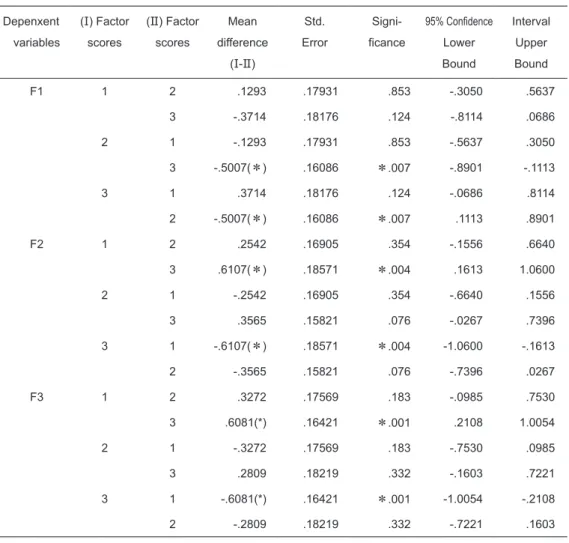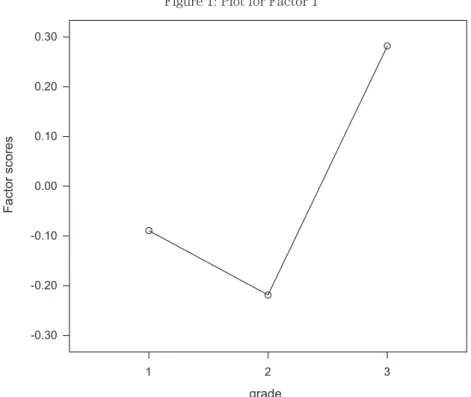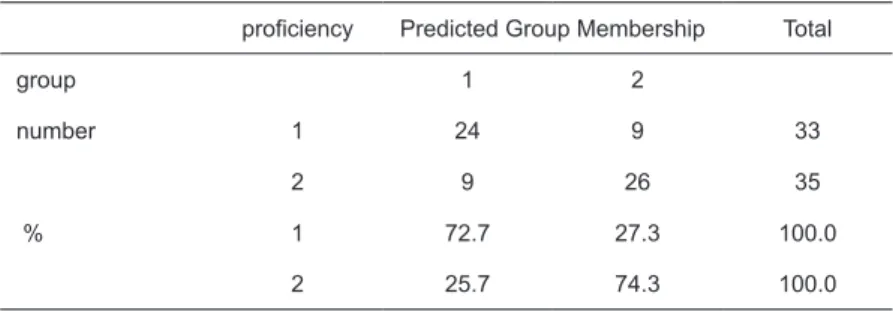Motivation to learn English in the context of
Japanese senior and junior high schools
Kazuya Sawada
言語学習に関する社会心理学および教育心理学的動機付け理論を背景とした34項目からな る質問紙を作成し、中学および高校生を被験者として調査を実施した。因子分析の結果被験 者に固有の動機付け因子が抽出され、多変量分散分析により被験者の学年、学校によってこ れらの因子の差異が明らかになった。これらの結果を基に、本論では英語学習者の動機の特 徴について考察し、判別分析により学習に成功する生徒の学習動機の要因を探る。
Introduction to motivation research
Much of the motivation research on language learning has been initiated and inspired by two Canadian psychologists, Robert Gardner and Wallace Lambert. According to Dörnyei (1994), Gardner and Lambert (1972) grounded motivation research in a social psychological framework. He states, “Although Gardener’s motivation construct did not go unchallenged over the years, it was not until the early 1990’s that a marked shift in thought appeared in papers on L2 motivation as researchers tried to reopen the research agenda in order to shed new light on the subject.” Dörnyei continues, “While acknowledging unanimously the fundamental importance of the Gardnerrian social psychological model, researchers were also calling for a more pragmatic, education-centered approach to motivation research, which would be consistent with the perceptions of practicing teachers and which would also be in line with the current results of mainstream educational psychological research” (p. 273). Throughout the 1990’s research on language learning motivation incorporated constructs from psychology. For instance, Williams & Burden (1997, p. 120) give an essentially cognitive definition of motivation.
Motivation may be construed as
• a state of cognitive and emotional arousal,
• which leads to a conscious decision to act, and
• which gives rise to a period of sustained intellectual and/or physical effort
• in order to attain a previously set goal (or goals).”
Cognitive psychologists discussed the reasons why people choose to act in certain ways and
they came to draw a distinction between intrinsic and extrinsic motivation. Deci and Ryan (1985) classified motivation into intrinsic motivation, the desire to engage in activities in anticipation of internally rewarding consequences such as feelings of competence and self-determination, and extrinsic motivation, the desire to engage in activities in anticipation of a reward from outside of and beyond the self.
But as Hayamizu (1997) argued, intrinsic and extrinsic motivation are not bipolar and antagonistic, but rather are located on a continuum of motivation types.
Williams & Burden (1997, p. 123) summarize Csikszentmihalyi and Nakamura’s definition as follows:
when the only reason for performing an act is to gain something outside an activity itself, such as passing an exam, or obtaining financial rewards, the motivation is likely to be extrinsic. When the experience of doing something generates interest and enjoyment, and the reason for performing the activity lies within the activity itself, then the motivation is likely to be intrinsic.
But it is highly unlikely that any human engages in a complex act such as language learning for only one reason.
Regarding motivation studies in Japan, Kimura, Nakata and Okumura (2001) argue that much of the research in Japan used Gardner’s approach for investigating motivation in the ESL context and also regarded Gardner’s findings to be applicable to the Japanese EFL situation. They go on to say: “However, since Gardner’s theory of motivation addresses the social context, not the individual learner, it is suggested that his theory alone cannot explain what motivates language learners in Japan.” Indeed more attention has been paid to the educational setting in investigating EFL learning motivation. For example, Yashima (2001) reevaluates Gardner’s social psychological theory of L2 learning motivation in the Japanese EFL context with a view of communication as a goal of English language teaching, since attitudes to other cultures are becoming relevant to English teaching in Japan. Kimura, Nakata and Okumura (2001) explore the types of language learning motivation possessed by Japanese EFL learners from diverse learning milieus. They employed a 50-item motivational questionnaire based on several motivational components from educational and social psychology. As they claim, the data they collected by using factor analysis indicate that the largest motivational factor is complex, with both intrinsic and integrative characteristics. With the extensive work by Gardner, the importance of integrative motivation in second/foreign language learning has received worldwide attention. In his lecture at Kansai University, Gardner (2001) explained the importance of Integrative Motivation as follows:
Our thesis is that regardless of the context, truly learning a second language so that it
becomes second nature to the individual requires considerable effort, attention, and persistence, and that this must be supported by something more than the immediate consequences. In many of our studies, we have demonstrated that this Motivation to learn the language is supported in part by a host of social attitudes that involve general reaction to other groups in general, and an interest in interacting with members of the group that speaks the language. We refer to this as Integrativeness. Furthermore, we have found that reactions to the language learning situation also serve to support the motivation. We refer to this as Attitudes toward the Learning Situation. The complex of Integrativeness, Attitudes toward the Learning Situation, and Motivation is all subsumed under the label Integrative Motivation.
Dörnyei’s (2001, p. 113) extended motivation framework discusses three motivational levels, the language level, the learner level, and the learning situation level. His rationale for the separation is worth noting here, “they seem to have a vital effect on the overall motivation independently of each other.” Dörnyei continues, “when the target language is the same, the same learner’s motivation can show vast differences as the function of the learning situation, that is, the appraisal of the language classroom (consider, for example, the effect of a bad or a good teacher).”
The present study replicates Kimura, Kimura & Okumura, and along with further analysis, discusses the results I obtained in the context of one high school and two junior high schools in the Kansai area.
Research Questions
1 What are some components of EFL motivation possessed by a sample of Japanese EFL learners?
2 Are the components of EFL motivation different for various Japanese learning situations, comprising two junior high schools and a senior high school?
3 What are the attitudes that best explain achievement in language learning?
Methods
Participants
The participants in this study were 204 EFL students from 3 different contexts. One is a group of 68 second year students at a private high school. The second is a group of 66 third year
students at a private junior high school. The third is a group of 76 first year students at a public junior high school.
Materials
The questionnaire used for the present study is a partially revised version of Dörnyei’ s (1990)motivation questionnaire. It consists of 34 items arranged in a 6-point Likert scale format, ranging from “strongly agree” to “strongly disagree”.
Procedure and Statistical Analysis
The questionnaire was administered in the Japanese language in July 2004 under the supervision of the participants’ English teachers. After the data were collected, descriptive statistics were computed for all the questionnaire items to check for skewness and kurtosis. There were 6 skewed items and they were deleted. The remaining data were then analyzed in two phases. First a factor analysis was performed to describe the underlying characteristics of language learning motivation of this population. This was followed by three other factor analyses for each learning situation(private senior high school, private junior high school and public junior high school), in order to investigate the relationship between language learning motivation and the learner factor of institutional grade. The result of the first factor analysis of all the samples for this study was submitted to one-way multivariate analysis of variance (MANOVA) for the comparison of the three groups.
Finally in order to investigate what motivational attitudes explain success in learning English at high school, a discriminant function analysis was performed to predict group membership using the items that have high loads on the first factor that I extracted in the above factor analysis. The result of a nation wide mock examination, which is similar to the typical university entrance examination, was used to divide the group into two levels, higher level and lower level, in terms of proficiency. Before using DISCRIM, univariate outliers were checked using the SPSS EXPLORE. No extreme values were found. The remaining data were then checked for multivariate outliers using Mahalanobis distance in SPSS REGRESSION. None were found. Homogeneity of variance- covariance matrices was tested using the Box M statistics in SPSS MANOVA. The Box M statistic was not significant, indicating that there was no serious problem in this study with homogeneity of variance-covariance matrices.
Table 1 gives the descriptive statistics for the 34 items.
Table 1: Descriptive Statistics
N Mean Std. Skewness Kurtosis
Std. Std. Std.
Variables Statistic Statistic Error Statistic Statistic Error Statistic Error ITEM1 203 4.2562 .08477 1.20781 -.300 .171 -.372 .340 ITEM2 204 3.7843 .09535 1.36188 -.064 .170 -.778 .339 ITEM3 204 3.7451 .10127 1.44649 -.128 .170 -.805 .339 ITEM4 204 2.7206 .09466 1.35202 .593 .170 -.073 .339 ITEM5 204 3.6176 .09429 1.34673 -.033 .170 -.568 .339 ITEM6 204 3.2843 .09081 1.29704 .046 .170 -.398 .339 ITEM7 204 3.5637 .09731 1.38992 -.072 .170 -.788 .339 ITEM8 204 3.5441 .09357 1.33650 -.083 .170 -.558 .339 ITEM9 204 3.0098 .09219 1.31677 -.005 .170 -.811 .339 ITEM10 204 3.7059 .09508 1.35798 -.275 .170 -.542 .339 ITEM11 203 3.7192 .08539 1.21662 -.246 .171 -.362 .340 ITEM12 204 3.8137 .08803 1.25734 -.409 .170 -.155 .339 ITEM13 204 4.1324 .08616 1.23062 -.527 .170 .113 .339 ITEM14 204 3.7549 .10163 1.45159 -.170 .170 -.752 .339 ITEM15 203 3.7438 .10272 1.46355 -.284 .171 -.768 .340 ITEM16 204 3.2157 .09226 1.31776 .248 .170 -.385 .339 ITEM17 203 2.7291 .11219 1.59842 .554 .171 -.869 .340 ITEM18 204 3.1324 .10692 1.52714 .185 .170 -.977 .339 ITEM19 203 3.4877 .10153 1.44661 -.134 .171 -.862 .340 ITEM20 204 4.2059 .10230 1.46108 -.573 .170 -.449 .339 ITEM21 204 4.2206 .09568 1.36651 -.604 .170 -.304 .339 ITEM22 204 3.8873 .09508 1.35808 -.294 .170 -.370 .339 ITEM23 203 3.6847 .09522 1.35673 .096 .171 -.587 .340 ITEM24 202 3.6238 .08952 1.27237 -.039 .171 -.437 .341 ITEM25 203 3.2562 .09168 1.30627 .174 .171 -.422 .340 ITEM26 203 2.3990 .08004 1.14035 .666 .171 .536 .340 ITEM27 203 3.4138 .08684 1.23729 -.006 .171 -.173 .340 ITEM28 202 2.6238 .10474 1.48861 .721 .171 -.302 .341 ITEM29 203 3.6700 .09713 1.38394 -.114 .171 -.474 .340 ITEM30 201 3.6816 .09511 1.34837 -.379 .172 -.374 .341 ITEM31 203 3.8621 .10001 1.42492 -.366 .171 -.524 .340 ITEM32 202 3.8960 .09735 1.38366 -.449 .171 -.327 .341 ITEM33 199 3.5729 .09958 1.40471 -.233 .172 -.634 .343 ITEM34 199 3.0905 .10786 1.52152 .280 .172 -.801 .343 Valid N
(listwise) 189
Statistical analyses were conducted using SPSS12. Cronbach’s alpha were computed for the 34 questionnaire items and a reliability of 0.883 was obtained.
Results
Using the Principal Component Analysis and Varimax Rotation, 8 components were extracted. Of the eight, three components had loadings not less than .400 from more than one item. Factor 1 received good loadings from more than 10 items. This factor is the largest component of language learning motivation for this sample. Factor one is basically about one’s interest in English language learning and the community where English is spoken and how important one considers language learning is and one’s willingness to get to know the people who speak it. So I label this as intrinsic integrative motivation. Factor 2 received good loadings from 4 items. It is basically about attitudes toward British and American culture. Factor 3 indicates attitudes toward language learning that concern communication rather than grammatical accuracy.
Table 2 summarizes the results of the factor analysis using varimax rotation. Eight factors had Eigenvalues over 1.00.
These eight factors accounted for 60.9 % of the variance. The loadings for each of the variables in this study on the eight factors are shown in Table 2. Furthest to the right, a column of communalities (h2) is presented in italics.
Table 2 Component
1 2 3 4 5 6 7 8 h2
VAR00001 .095 .182 .602 .128 -.138 -.074 .050 .483 .681
VAR00002 .236 .026 .744 .041 .093 .027 .160 -.142 .667
VAR00003 .201 .035 .749 .120 .219 .024 -.041 -.077 .673
VAR00004 .267 .252 .462 -.088 .510 -.031 -.179 -.194 .686
VAR00005 -.040 -.104 -.124 -.188 -.797 -.086 -.009 .047 .708
VAR00006 .395 .163 .428 -.047 .484 .081 -.114 -.110 .634
VAR00007 -.753 -.008 .000 -.027 -.252 -.058 .026 -.026 .635
VAR00008 .567 .400 .205 -.036 .095 -.099 .131 .158 .585
VAR00009 .765 .195 .126 -.040 .163 .067 .145 -.039 .695
VAR00010 .472 .463 .418 .043 .204 .098 -.066 -.013 .669
VAR00011 .245 .754 .013 .191 .134 .085 -.053 .094 .702
VAR00012 .055 .679 -.003 .164 .207 .248 .238 -.188 .687
VAR00014 .222 .720 .113 -.001 -.048 -.341 .087 .086 .714
VAR00015 -.033 .470 .188 .407 -.034 -.146 .217 -.286 .574
VAR00016 .531 .304 .313 .429 -.031 -.140 -.087 .145 .706
VAR00018 .106 .155 .092 .835 -.046 -.129 .058 -.016 .763
VAR00019 .062 .080 -.008 .815 .108 .179 .046 -.047 .723
VAR00022 .002 .336 -.062 .129 -.013 .183 .716 -.101 .690
VAR00024 -.123 -.079 .283 .080 -.030 .725 .077 .201 .681
VAR00025 .238 .071 -.155 -.064 -.020 .792 -.006 .044 .719
VAR00027 -.196 -.029 -.006 .132 -.720 .171 -.124 -.200 .660
VAR00029 .299 -.071 .115 .000 .065 -.118 .726 .223 .702
VAR00030 .598 .213 .321 .128 .035 .026 .279 -.094 .612
VAR00031 .457 .270 .352 .083 .001 .228 .191 -.170 .530
VAR00032 .511 .516 .185 .093 .144 .044 .102 .094 .612
VAR00033 .344 .307 .229 .318 -.093 .137 .344 -.362 .643
VAR00034 .656 -.001 .229 .395 -.072 -.028 .055 -.161 .674
VAR00023 -.052 .019 -.158 -.101 .058 .250 .075 .785 .726
Table 3 describes the three main factors of the eight.
Table 3: Results of Factor Analysis for All Subjects (N=204)
Item Questionnaire Items F1 F2 F3
2 I would like to learn as many languages as possible. .566 3 After finishing English, I‘d like to start learning another language. .562
4 For me language learning is a hobby. .575
6 Language learning is an exciting activity. .613
8 Language learning often gives me a feeling of success. .666
9 Language learning often makes me happy. .695
10 Studying English is important to me because it provides an interesting
intellectual activity. .763
11 English proficiency is part of the general culture. .598 12 I am learning English to become more educated. .520 14 English proficiency is indispensable for a Japanese person to be able
to live a valuable and colourful life. .524
15 Everybody in Japan should learn to at least an intermediate level. .442 16 The more I learn about the British/Americans, the more I like them. .699 30 I believe that I’ll be able to learn English to an extent that satisfies me. .725 32 English proficiency is important to me because it will allow me to get to
know various cultures and peoples. .729
33 Studying English is important to me because it offers a new challenge
in my life, which has otherwise become a bit monotonous. .622 34 I am learning English because I would like to spend a longer period
abroad. .624
18 Britain and America are among the most exciting countries of the
world. .575
19 British/American culture is of vital importance in the world today. .497 27 I think language learning is more difficult for me than for the average
learner. .501
22 English proficiency would have financial benefits for me. .433 .400 23 I don’t think it is very important to speak elaborately in a foreign
language; the point is only to be able to express my thoughts. .597 24 Pronunciation in a foreign language is important only insofar as one
can make himself/herself understood. .440
25 It doesn’t matter if I make mistakes in a foreign language. .663
The other three factor analyses for each group of the participants showed quite different component matrices. The senior high group and the third year junior high group showed interest in British and American culture. In the senior high group it appeared clearly in the second component. In the junior high group it appeared clearly in the first principal component. But the first year junior high group showed less interest in American and British culture. In this case, it appeared in the fourth component whose % of variance was approximately 7%. This indicates that early instruction in junior high does not necessarily lead to interest in Anglo culture. As Kimura, Nakata, and Okumura’s study showed, only junior high students showed strong instrumental motivation. High school students tend to study for the intellectual satisfaction rather than for the profit they might get in the future, which is quite understandable when I reflect on the academic material that we are using in our regular courses.
The three factors, which are intrinsic integrative motivation factor, interest in English speaking culture factor and motivation for communication factor, were submitted to one-way multivariate analysis of variance (MANOVA) as dependent variables with participants’ grades 1-3 (1 high school 2nd year, 2 junior high 3rd year, and 3 public junior high 1st year )as independent variables. All multivariate F statistics (i.e.,Pillai’s trace, Wilks’ lambda, Hotelling’s trace, and Roy’s largest root) were siginificant at the .001 alpha level. Therefore univariate follow up ANOVAs were run, one for each dependent variable. Table 4 shows the result. As for Factor 1 (integrativeness), it shows there was a significant difference between junior high 3rd year and 1st year but there was no significant difference between high school and junior high school. As for Factor2 (interest in English speaking culture), there was a significant difference between high school and junior high
freshmen. Regarding Factor 3, there was a significant difference between high school and junior high first year.
Table 4 : Tamhane’s T2 (M) Depenxent
variables
(I) Factor scores
(II) Factor scores
Mean difference
(I-II)
Std. Error
Signi- ficance
95% Confidence Lower Bound
Interval Upper Bound
F1 1 2 .1293 .17931 .853 -.3050 .5637
3 -.3714 .18176 .124 -.8114 .0686
2 1 -.1293 .17931 .853 -.5637 .3050
3 -.5007(*) .16086 *.007 -.8901 -.1113
3 1 .3714 .18176 .124 -.0686 .8114
2 -.5007(*) .16086 *.007 .1113 .8901
F2 1 2 .2542 .16905 .354 -.1556 .6640
3 .6107(*) .18571 *.004 .1613 1.0600
2 1 -.2542 .16905 .354 -.6640 .1556
3 .3565 .15821 .076 -.0267 .7396
3 1 -.6107(*) .18571 *.004 -1.0600 -.1613
2 -.3565 .15821 .076 -.7396 .0267
F3 1 2 .3272 .17569 .183 -.0985 .7530
3 .6081(*) .16421 *.001 .2108 1.0054
2 1 -.3272 .17569 .183 -.7530 .0985
3 .2809 .18219 .332 -.1603 .7221
3 1 -.6081(*) .16421 *.001 -1.0054 -.2108
2 -.2809 .18219 .332 -.7221 .1603
Based on the observed mean Mean difference significant at .05 level
1 refers to senior high school, 2 refers to the third year of a private junior high school and 3 the first year of a public school.
Figure 1 shows an alarming figure that show the decline of factors scores for Factor 1, which consists of intrinsic, integrative motivation. This means learners might have lost their interest in learning English itself.
Figure 1: Plot for Factor 1
1 2 3
-0.30 -0.20 -0.10 0.00 0.10 0.20 0.30
Factor scores
grade
Table 5 shows the result of the discriminant analysis.
Table 5: Standardized canonical discriminant function coefficients Function
1
ITEM8 .549
ITEM9 .472
ITEM10 -.135
ITEM11 .207
ITEM12 -.172
ITEM32 .247
Items 8 (Language learning often gives me a feeling of success and 9 (Language learning makes me happy) contribute most to the division of the two groups, the higher group and the lower group. These Factor 1 items can predict whether a learner is proficient in terms of a proficiency test that is similar to the typical university entrance examination. Although entrance examinations test only a partial proficiency of high school learners, having learners acquire such skills is
considered to be an important objective for high school teachers. A part of Factor 1 scores predicts fairly well whether learners succeed in the proficiency test mentioned above. And discriminant function analysis conducted here strongly suggests item 8 and 9 are great predictors of success in acquiring English proficiency. Therefore in order to enhance learning, it is suggested that we should give them a feeling of success and happiness in one way or another in our instruction in the first place. The following table shows how reliable that prediction is.
Table 6 shows that 72.7% of those who were predicted to be higher were classified higher on the actual test and 74.3% of those who were predicted to be lower were classified lower in the discriminant analysis. In other words, these items if combined with some tasks, might even work as a placement test.
Table 6: Classification results
proficiency Predicted Group Membership Total
group 1 2
number 1 24 9 33
2 9 26 35
% 1 72.7 27.3 100.0
2 25.7 74.3 100.0
73.5% of original grouped cases correctly classified
Discussion
Do Japanese students have the kind of learning motivation we want them to have? The students in this study seem to have attitudes that, according to their guidelines, the Ministry of Education and Science would want learners to have.
The fact that there is a significant difference in terms of intrinsic integrative motivation between our junior high and public junior high freshmen, which explains a considerable part of the motivation that the participants in this study have, may be bad news for our school. It means freshmen may have a higher integrative motivation than our third year students in junior high school. But it is easy to imagine how this has happened. The teaching material becomes more difficult as the year progresses, so students begin to lose the initial eagerness to learn and it is difficult for students to sustain motivation. As a result they feel a sense of success or happiness less frequently.
But I do not think that this is something unavoidable. It is the teacher’s job to give learners
a sense of satisfaction and success during the course. As Gardner mentioned in his lecture (2001),
“I believe, however, that research in the classroom should be supported, and that the results do ultimately have an effect on the classroom environment. I believe this is true of our research on integrative motivation.” Not so long ago, language acquisition was considered to be a matter of aptitude and intelligence. Gardner continues, “Now attitudes and motivation are generally accepted as playing a role in second language acquisition, and even classroom instruction is now directed to changing or strengthening motivation in addition to teaching the language.” Williams and Burden point out (p. 117), an instrumental orientation may be important in the Japanese EFL context where people do not usually use English. Naturally there is some instrumental motivation among the participants in this study but it is not the major component that one might imagine. The discriminant function analysis that followed showed that those who feel that language learning often gives a feeling of success or that language learning often brings about happiness are likely to be proficient in the language. Then the teacher’s job is to give learners a positive feeling of achievement. Differences in scores for Factor 1(intrinsic integrative motivation) help to predict who will have higher proficiency than others. As we can see in Table 5, we should focus on items 8,9, and 32. These are closely related to the most essential motivational components. As Dörnyei
& Ottó (1998) propose, “From the point of view of designing motivational classroom interventions we need a particularly detailed and somewhat eclectic model that would list all the main motives that are likely to have an impact on learning achievement. One of the principles we need to take into consideration is goal theories, which propose that human action is spurred by purpose and for action to take place, goals have to be set and pursued by choice.” Dörnyei (2001, p. 97) adds,
“Students constantly evaluate how well they are doing in terms of approaching the desired outcome, and if they feel that their action is conducive to reaching that outcome they experience a feeling of success, which then provides further motivation.” Dörnyei (2002) discusses the importance of task specific motivation and group dynamics while doing a task. But as we cannot explain the complexity of motivation in one theory, we will have to create an eclectic model to enhance learners’ motivation or what Gardener calls Attitudes toward the Learning Situation.
Conclusion
The findings of this study support a few suggestions that have been made about language learning motivation. The data extracted by factor analysis indicate that the largest motivational factor in English learning among the Japanese EFL students is complex, with intrinsic and integrative characteristics. The second factor (instrumental motivation and interest in English
speaking cultures) was not as clear. The third factor indicates learners’ motivation to communicate in English. The discriminant function analysis that followed showed that some items that appeared in the first factor can predict learners’ success in a proficient test and it suggests that teachers can play an important role in enhancing learners’ motivation. The limitation of this study is the small number of items and a relatively small sample size. Also the data were gathered only in two schools. Their results are not necessarily true of other Japanese EFL contexts. There is a limitation to factor analysis research because motivation is such a complex construct that a few components alone cannot explain everything that is going on in the mind of the learner. So the study should be followed by a long term, introspective method to further understand the construct and reach a more useful classroom intervention.
Dörnyei & Ottó conclude that having reviewed the numerous components, it is difficult to imagine that by focusing on only a few selected factors they would be able to explain a large enough proportion of variance in motivated learning behaviour.
Nonetheless, the result gave me a direction which I should take. The fact that many successful students learn because they feel a sense of happiness suggests the classroom situation can play a key role in enhancing motivation. Dörnyei (1994, p. 281) writes under the heading
“learner level”:
Promote the students’ self-efficacy with regard to achieving learning goals by teaching students learning and communication strategies, as well as strategies for information processing and problem-solving, helping them to develop realistic expectations of what can be achieved in a given period, and telling them about your own difficulties in language learning. Motivation is an entity that changes overtime.
Considering the characteristics that each group of learners have, the teacher must think of strategies to motivate language learners and study the nature of learners’ strategies that lead to unhampered motivation to keep making an effort. The strategies to motivate learners should be empirically studied over time.
One strategy does not always work for everyone. Researchers on motivation strategies should also take individual differences into consideration. The present study only considered the language and learner levels. To make motivation study more relevant to the classroom, further study should also put “the learning situation level”, according to MacIntyre (2002), “over which educators have the most control”, into focus.
Bibliography
Deci, E. L., & Ryan, R. M. (1985). Intrinsic motivation and self-determination in human behavior. New York: Plenum Press.
Dörnyei & Z. (1994). Motivation and motivating in the foreign language classroom. The modern language journal, 78(3), 273-284.
Dörnyei, Z. & Ottó, I.(1998). Motivation in action: A process model of L2 motivation. Working Paper in Applied Linguistics, 4, 43-69. Thames Valley University, London.
Dörnyei, Z. (2001a). Teaching and researching motivation. Essex: Pearson Education.
Dörnyei, Z. (2001b). Motivational strategies in the language classroom. Cambridge, England: Cambridge University Press.
Dörnyei, Z.(2002). The motivational basis of language learning tasks. In P. Robinson (Ed.), Individual differences in second language acquisition (pp. 137-158). Amsterdam: John Benjamins.
Gardner, R. C., & Lambert, W. E. (1972). Attitudes and motivation in second language learning. Rowley, MA: Newsbury House.
Gardner, R.C. (2001). Integrative motivation and second language learning: practical issues. Journal of foreign language education and research, 2. 71-91. Institute of foreign language education and research: Kansai University.
Hayamizu,T. (1997). Between intrinsic and extrinsic motivation:Examination of reasons for academic study based on the theory of internationalization. Japanese Psychological Research, 39(2), 98-108. Kimura, Y., Nakata, Y., & Okumura, T. (2001). Language learning motivation of EFL learners in Japan − a
cross-sectional analysis of various learning Milieus. JALT Journal, 23 (1). 47-68.
MacIntyre, P. (2002). Motivation, anxiety and emotion in second language acquisition. In P. Robinson (Ed.), Individual differences in second language acquisition (pp. 45-68). Amsterdam: John Benjamins. Oxford, R., & Shearin, J. (1994). Language learning motivation: Expanding the theoretical framework.
Modern Language Journal, 78(1)12-28.
Williams, M., & Burden, R. L. (1997). Psychology for language teachers: A social constructivist approach. Cambridge: Cambridge University Press.
Yashima, T. (2001). International posture and foreign language learning motivation — Reevaluation of the social psychological theory in the Japanese EFL context — Journal of Foreign Language Education and Research, 1, 33-45.

